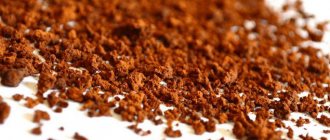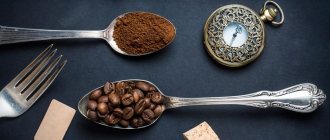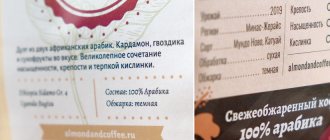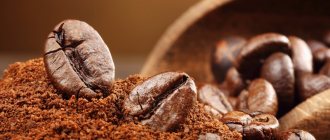History of freeze-dried coffee
Even in a regular freezer, food tends to dry out a little over time. The lower the pressure and temperature, the faster the drying process occurs, and in a vacuum, water evaporates almost instantly.
The technology of freeze drying (freezing, sublimation), developed in 1906 by the French biophysicist Jacques-Arsene d'Arsonval, is based on this natural property of water. The method was subsequently used to make vaccines. During World War II, the American scientific organization National Research Corporation (NRC) used freeze-drying technology to produce antibiotics and transport blood serum for the army.
After the war, NRC scientists turned to civilian projects. It turned out that when dry foods are frozen, they retain much more nutrients than when cooked. Experiments with freeze-drying coffee lasted more than 10 years, and only in 1965 the Nestle company released the world's first instant freeze-dried coffee, Nescafe Gold.
Consumers liked the drink so much that over the next 15 years, most well-known companies also began to produce instant coffee using the sublimation method. By the 1980s, up to 40% of instant coffee was produced using this method. The freezing technology is called freez dried.
Don Valencia, head of research and development at Starbooks, has spent over 20 years creating the perfect freeze-dried coffee, indistinguishable from the real thing. The scientist experimented not only with the temperature and time of freezing, but also selected varieties of coffee beans that were most suitable for making freeze-dried coffee, and used various roasting methods.
At the beginning of the 21st century, Mr. Valencia managed to obtain freeze-dried coffee called “Stardust.” It is now added to all Pepsi canned coffee drinks. After the scientist's death in 2007, Stardust was renamed in honor of its inventor, and is now called Via.
Differences between freeze-dried coffee and powdered and granulated coffee
You often read that instant coffee is made from low-quality beans, which are sometimes even difficult to sell in their raw form. However, freeze-dried coffee, unlike granulated and powdered coffee, retains some of the aroma and taste of the original raw material. Therefore, to produce such coffee, higher quality beans are needed: ripened, calibrated, cleared of pulp in compliance with technology, and not emitting an unpleasant odor.
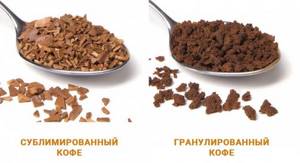
What does the term “sublimated” mean?
This type of coffee is produced using the freeze dried technology, which was created relatively recently, at the end of the twentieth century. The basis of the technology is extracting water from grains in a vacuum. This is a complex and lengthy process, and therefore the product is more expensive. Unlike powdered or granulated coffee drinks, freeze-dried coffee has a richer aroma, brighter and more pleasant taste. Let's take a closer look at how sublimation occurs.
Production stages:
- At the factory, the grains are roasted and ground into a powdery mass. After which it is boiled in a special tank under pressure for about 3-4 hours, where steam saturated with essential oils is collected.
- The next step involves very rapid vacuum freezing. This is necessary to preserve the aroma. During the freezing process, the liquid evaporates, leaving only an absolutely dry frozen mass in the form of a slab.
- Next, the slab is crushed into pieces, such as we see in finished form in jars.
- At the final stage, the crystals are enriched with essential oils collected during cooking. Melting in your mouth, these light brown, delicious crystals convey the full power of caffeine, and the delicious aroma of the drink can only be compared to a drink made from roasted beans.
There are varieties of freeze-dried coffee, determined by the presence of different flavors. However, they all have one thing in common - the content of natural oils and extracts.

How to make freeze-dried coffee
Making freeze-dried coffee begins with roasting the beans. Every company has its own secret. For example, the producers of Colombian coffee Buencafé are proud that they use only high-quality Arabica beans, and roast the beans very slowly, which eliminates the appearance of a burnt smell and taste in the finished product.
After roasting, the beans are ground, aromatic substances are extracted, and brewed to obtain coffee concentrate. But if for powdered and granulated coffee the concentrate is sprayed with a stream of hot air, then when producing freeze-dried coffee the concentrate is cooled to –6 °C, which makes it more viscous.
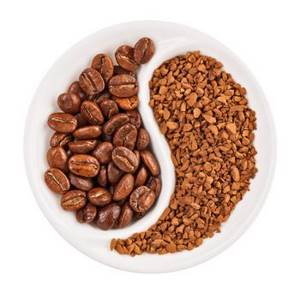
The semi-frozen liquid is placed on a conveyor belt and deep frozen to a temperature of –40 to –50 °C. The faster the freezing, the lighter the freeze-dried coffee granules will be. The ice is then crushed and sifted. Large pieces of ice are sent to a vacuum cryochamber, small pieces are sent for re-freezing. In a vacuum cryochamber, water evaporates. The size of the granules depends on the size of the ice floes. If you dry too small pieces of ice, you will get a powder, which is unacceptable according to the standard.
Coffee concentrate contains aromatic substances (although much less of them than in natural beans). When dried hot, they completely evaporate, but when frozen, they are preserved. That’s why manufacturers indicate on the packaging: “natural freeze-dried coffee.” However, the granules are usually additionally flavored.
Freeze-dried coffee granules are harder than those obtained by hot drying granules. Frozen coffee dissolves slightly more slowly in water.
Freeze-dried coffee manufacturing technology
Instant coffee is very popular among people due to its convenience. To prepare a portion of an invigorating, burning drink, no special equipment, special skills or time are required. Just boil water in a kettle, pour a spoonful of granules into a cup and pour boiling water over them. After 2 minutes the drink is ready.
Powdered and granulated coffee has little in common with natural coffee. Its manufacturers sin by adding preservatives, flavorings and flavorings. According to experts, the freeze-dried drink is the closest to the original due to its unique manufacturing technology.
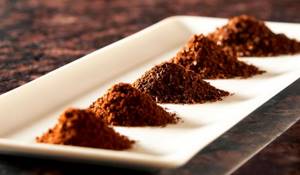
How is freeze-dried coffee made in production? Contrary to popular myth, it is not coffee husks and garbage that are used to prepare instant drinks, but whole beans.
The process of obtaining a freeze-dried drink is as follows:
- Carefully selected, quality beans are roasted and ground into powder.
- The resulting “coffee flour” is poured with water and boiled in hermetically sealed metal containers for several hours.
- The steam generated during the cooking process is removed through a special pipe system. Inside it there are filters that can capture and preserve essential oils, which are responsible for the unique aroma of the drink.
- The brewed coffee is flash-frozen and then subjected to low-pressure vacuum systems. At the same time, all excess liquid is removed from it. This process is similar to what happens to vegetables and fruits placed in the freezer - they dry out.
- The dehydrated coffee mass is crushed using knives into granules in the form of pyramids familiar to the buyer.
- The freeze-dried coffee prepared in this way is soaked in essential oils collected by the filter system during the brewing stage. This allows you to return it to its usual aroma.
- Manufacturers claim that this coffee is similar in composition to natural coffee and retains all its beneficial properties.

How to choose freeze-dried coffee
Freeze-dried coffee is most often sold in transparent cans; you can choose a quality product based on appearance and label:
- there should be no powder at the bottom of the jar;
- Responsible producers indicate on the label what varieties the freeze-dried coffee is made from: 100% Arabica or a mixture of Arabica and Robusta. It is believed that 100% Arabica coffee is better, but this is a matter of taste;
- Preference should be given to coffee with natural flavors;
- The color of the granules only indicates the speed of freezing. When quickly frozen, the granules become lighter in color.
Important! If the drink has a burnt cork taste, it means that the roasting technology was violated during the production of freeze-dried coffee, or low-grade, poorly calibrated beans were used. It is better not to buy products from this brand. A musty smell is also unacceptable (appears when the technology for extracting aromatic substances from ground grains is violated).
How to choose
Here it should immediately be noted that there are no established rules for selection. But, these tips will help you choose a quality product:
- The packaging material deserves special attention. Preference should be given to glass or a special soft version. Plastic packaging should not be taken.
- You cannot take a product that has been stored for more than 2 years.
- The drink must be hermetically sealed.
- Coffee pyramids must be smooth, and the presence of coffee powder in the packaging indicates that the production technology and the standards established by GOST were violated.
IMPORTANT! You need to understand that the best freeze-dried coffee has the highest cost. It is impossible to buy a quality product for little money.
Famous brands of freeze-dried coffee
Starbucks Via Instant – there are several types on sale with varying degrees of roasting. The drink tastes like coffee brewed in a French press;
Bushido is a Japanese dark roasted freeze-dried coffee. The aroma is intense, close to natural, the taste is with a pleasant bitterness. Coffee dissolves only in hot water;
Carte Noire is a premium French coffee, there are several types on sale. The granules dissolve in cold water;
Tchibo Exclusive - coffee with a pleasant taste and aroma, belongs to the economy segment;
Nescafe is an inexpensive and very popular coffee. The drink smells nice, but the taste is inexpressive.
How to brew freeze-dried coffee correctly
Ingredients:
- 1–2 tsp. freeze-dried coffee;
- 1–2 tsp. Sahara;
- 100–150 ml of water.
Recipe
Coffee and sugar are poured into a preheated cup, a teaspoon of water is added and thoroughly rubbed to form foam. Then add the rest of the water. It should not be hotter than +90 °C. To heat water, it is boiled until air bubbles appear. You should turn off the kettle and wait 2-3 minutes until the water cools down a little.
The more intensively you beat the coffee with sugar, the more fluffy the foam will be (although whipping freeze-dried coffee is harder than powdered coffee). If you are preparing several servings of the drink, it is convenient to use a mixer for whipping. You can decorate muffins with this foam. Sometimes it is laid on top of natural coffee brewed in a French press or Chemex.

In appearance, freeze-dried coffee cannot be distinguished from coffee brewed by other methods.
Freeze-dried coffee makes delicious milk-coffee cocktails.

